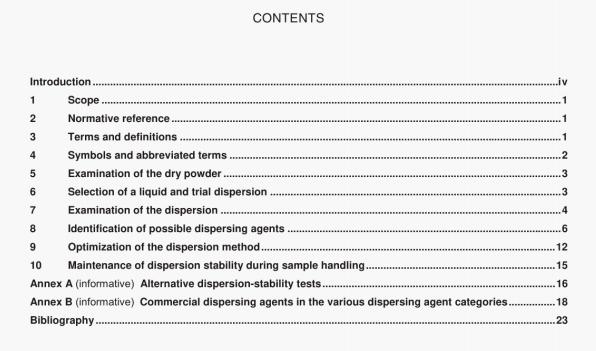AS 4784:2003 pdf – Sample preparation for particle size analysis–Dispersing procedures for powders in liquids.
Put two drops (or 0,1 g) of the liquid on an etch-roughened glass plate (“frosted” glass). Blend in a roughly equal amount of powder by sprinkling powder on the liquid surface and wbbing it into the liquid using a circular motion of a 10 mm wide spatula. applying a moderate amount of pressure (sufficient to read 1 kg on the scale of a balance). The objective is to wet all the powder surfaces and to break up all clumps of powder into primary particles. The high concentration of solids provides crowded conditions that favour collision between clumps and breakup into primary particles. These crowded conditions will also favour flocculation unless the particles repel one another.
6.3 Preparation of a dilute dispersion of the powder
Make a dilute dispersion (4 % by mass) from the concentrated paste by adding a few drops at a time of the liquid and blending in with the spatula until 50 drops (about 2,5 g) of liquid have been added. This quantity should be sufficient for examination with a microscope. If a larger quantity is required for other types of test, the analyst shall follow the instructions given in 7.2.
7 Examination of the dispersion
7.1 Evaluate for under- or over-grinding
Examine the dilute dispersion using an optical microscope (for particles larger than 1 pm in diameter) or an electron microscope (for particles smaller than 1 pm in diameter). Use x 200 magnification with the optical microscope and view the particles by transmitted light.
Note whether the clumps originally seen in the dry powder have completely broken up during the procedure for making the paste and diluting it, If not, the analyst shall make a new dispersion using ultrasonic treatment (see 9.2). The analyst shall evaluate this new dispersion and increase, as needed, the energy put in to breakup clumps until full dispersion is attained.
Note what fraction of primary particles have become broken during the procedure for making the paste and diluting It. If the fraction of particles broken is over 5 %, the analyst shall make a new dispersion by simply stirring the powder into the liquid. The analyst shall evaluate this new dispersion and increase the energy put in to breakup clumps as needed until full dispersion is attained with less than 5 % breakage of primary particles (see 9.2).
Record the conditions that avoid under- or over-grinding and use these to prepare dispersions for evaluation until the dump breakup process is optimized according to the procedures in 7.2.
7.2 Evaluation of stability
7.2.1 Introduction
If the suspending liquid has a viscosity below 10 mPas and the particles are well-dispersed, very small particles will appear to move randomly in the microscope’s field of view. Particles in the 1 pm to 5 pm range are best for observing this effect. Note that, even if the powder consists mostly of larger-size particles, there are likely to be a few particles inside the 1 pm to 5 pm range that can indicate whether or not the dispersion is stable. If the particles are smaller than 1 pm some other form of evaluation shall be used.
AS 4784:2003 pdf – Sample preparation for particle size analysis–Dispersing procedures for powders in liquids
